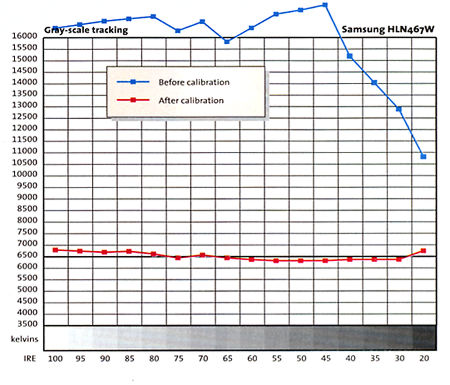Samsung HLN467W DLP RPTV Page 2
My sole quibbles with the Samsung's color presentation were that greens sometimes looked a bit hot and AstroTurfy, and sometimes Caucasian flesh tones looked a bit salmony. Reds were pleasingly rich and not at all orangey. The key to the Samsung's overall success was its balance of strong picture strengths and the minimization of DLP's weaknesses.
 "You tell me what's wrong with that picture," I challenged video-enthusiast friends. Their answer was usually "Not much," even from those who are familiar with DLP's problems and can easily point them out, including the color-wheel–induced "rainbow effect." If you're not hypersensitive to rainbows, and unless you dart your eyes around while watching, this shouldn't be an issue with the HLN467W.
"You tell me what's wrong with that picture," I challenged video-enthusiast friends. Their answer was usually "Not much," even from those who are familiar with DLP's problems and can easily point them out, including the color-wheel–induced "rainbow effect." If you're not hypersensitive to rainbows, and unless you dart your eyes around while watching, this shouldn't be an issue with the HLN467W.
Wide Open Choices
There are many choices in 46-inch HD RPTVs at the $4500 price point. CRT-based RPTVs still offer the best and biggest picture quality for the least amount of money, but they're deeper, heavier, and not designed to sit on a table-top.
LCD RPTV prices are dropping rapidly, and many models have reached parity with DLP or even lower; for example, Sony's 50-inch KF-50WE610 Grand Wega has an MSRP of $3299. These triple-panel LCD sets don't have color wheels like single-chip DLP sets, so they don't suffer from rainbow effects, but LCD black levels are not quite as good as current DLP models, and LCD response time is still slow compared to DLP.
If you want to pick the HLN467W's picture quality apart (and you wouldn't be reading this review if you didn't), the DLP technology, more than Samsung's application of it, is the real issue. You can point to the video noise visible when you get too close, to the somewhat restricted vertical viewing area compared to plasmas, to blacks that are less than jet black, and to the rainbow effect. But overall, DLP offers a smart balance of pluses and minuses, and that's why it's been so successful in the marketplace. As with all of these technologies, your reaction will depend on your prejudices and taste.
Conclusion
The Samsung HLN467W is a smart-looking television: Its slim-bezel design makes it appear to be all screen and no chassis, and it's practical—the chassis is barely wider than the screen itself. However, a few visitors were at first confused when the black cloth section below the screen didn't light up.
The HLN467W combines an easy-to-use operating system, an ergonomically pleasing if not particularly attractive-looking remote control, and impressive picture quality within the limitations of the DLP technology. However, unless you watch nothing but cartoons, ISF calibration is a necessity. [While incorrect color won't be as obvious with animation as with live-action material, properly rendered color is just as important to those who appreciate animation as an important art form.—Ed.]

Late last year, Texas Instruments introduced an improved HD2 chip, the HD2+, which promised higher contrast ratios. But I wouldn't let that stop me from buying a Samsung HLN467W if I needed a set now. If time isn't an issue, you might want to wait for the next generation of sets, based on the HD2+ and HD3, both of which offer the same 1280x720 resolution with other improvements. Then there's the xHD3, which provides 1920x1080 resolution; Samsung showed a prototype with that chip at the last Consumer Electronics Show, but it probably won't show up in a production model for some time. There's always something new and improved waiting in the wings.
As for the HLN467W . . . to answer my reviewer friend's question, yes, I could live with it. I kept it longer than I should have, and delayed writ-ing this review so
I could honestly answer that question and test the set's reliability, which was flawless. My reviewer friend couldn't live with the HLN 467W, and I can't predict your reaction to it. But judging by Sam-sung's sales figures, this series of sets' popularity has surprised everyone in the industry, in-cluding Samsung. Having spent many months with the HLN467W, I un-derstand its popularity, and I suspect most who have bought one have no regrets.
























































